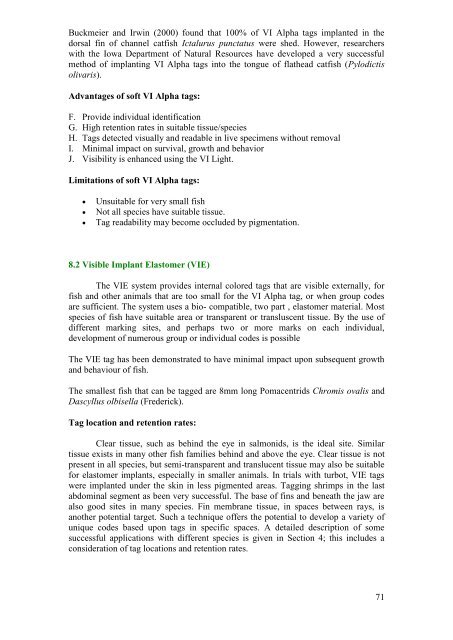standardization of records keeping in indian zoos - Central Zoo ...
standardization of records keeping in indian zoos - Central Zoo ...
standardization of records keeping in indian zoos - Central Zoo ...
Create successful ePaper yourself
Turn your PDF publications into a flip-book with our unique Google optimized e-Paper software.
Buckmeier and Irw<strong>in</strong> (2000) found that 100% <strong>of</strong> VI Alpha tags implanted <strong>in</strong> the<br />
dorsal f<strong>in</strong> <strong>of</strong> channel catfish Ictalurus punctatus were shed. However, researchers<br />
with the Iowa Department <strong>of</strong> Natural Resources have developed a very successful<br />
method <strong>of</strong> implant<strong>in</strong>g VI Alpha tags <strong>in</strong>to the tongue <strong>of</strong> flathead catfish (Pylodictis<br />
olivaris).<br />
Advantages <strong>of</strong> s<strong>of</strong>t VI Alpha tags:<br />
F. Provide <strong>in</strong>dividual identification<br />
G. High retention rates <strong>in</strong> suitable tissue/species<br />
H. Tags detected visually and readable <strong>in</strong> live specimens without removal<br />
I. M<strong>in</strong>imal impact on survival, growth and behavior<br />
J. Visibility is enhanced us<strong>in</strong>g the VI Light.<br />
Limitations <strong>of</strong> s<strong>of</strong>t VI Alpha tags:<br />
Unsuitable for very small fish<br />
Not all species have suitable tissue.<br />
Tag readability may become occluded by pigmentation.<br />
8.2 Visible Implant Elastomer (VIE)<br />
The VIE system provides <strong>in</strong>ternal colored tags that are visible externally, for<br />
fish and other animals that are too small for the VI Alpha tag, or when group codes<br />
are sufficient. The system uses a bio- compatible, two part , elastomer material. Most<br />
species <strong>of</strong> fish have suitable area or transparent or transluscent tissue. By the use <strong>of</strong><br />
different mark<strong>in</strong>g sites, and perhaps two or more marks on each <strong>in</strong>dividual,<br />
development <strong>of</strong> numerous group or <strong>in</strong>dividual codes is possible<br />
The VIE tag has been demonstrated to have m<strong>in</strong>imal impact upon subsequent growth<br />
and behaviour <strong>of</strong> fish.<br />
The smallest fish that can be tagged are 8mm long Pomacentrids Chromis ovalis and<br />
Dascyllus olbisella (Frederick).<br />
Tag location and retention rates:<br />
Clear tissue, such as beh<strong>in</strong>d the eye <strong>in</strong> salmonids, is the ideal site. Similar<br />
tissue exists <strong>in</strong> many other fish families beh<strong>in</strong>d and above the eye. Clear tissue is not<br />
present <strong>in</strong> all species, but semi-transparent and translucent tissue may also be suitable<br />
for elastomer implants, especially <strong>in</strong> smaller animals. In trials with turbot, VIE tags<br />
were implanted under the sk<strong>in</strong> <strong>in</strong> less pigmented areas. Tagg<strong>in</strong>g shrimps <strong>in</strong> the last<br />
abdom<strong>in</strong>al segment as been very successful. The base <strong>of</strong> f<strong>in</strong>s and beneath the jaw are<br />
also good sites <strong>in</strong> many species. F<strong>in</strong> membrane tissue, <strong>in</strong> spaces between rays, is<br />
another potential target. Such a technique <strong>of</strong>fers the potential to develop a variety <strong>of</strong><br />
unique codes based upon tags <strong>in</strong> specific spaces. A detailed description <strong>of</strong> some<br />
successful applications with different species is given <strong>in</strong> Section 4; this <strong>in</strong>cludes a<br />
consideration <strong>of</strong> tag locations and retention rates.<br />
71
















